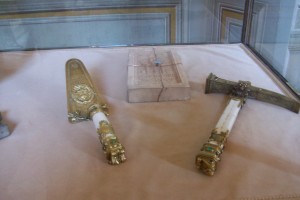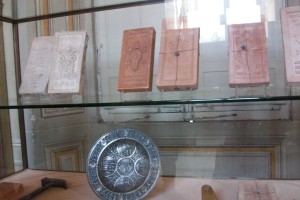Holy Year 1975 in St. Peter’s Basilica
July 15th , 2016 Tagged with: Basilica • Holy Door • Holy Year • pilgrims • Rome • St. Peter's basilica • Via Francigena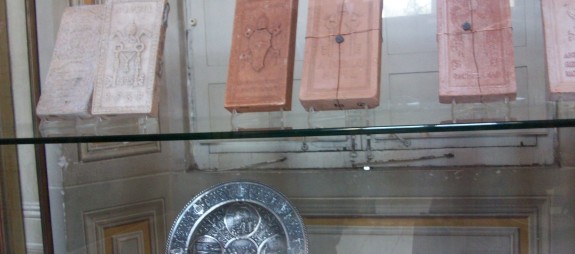
“..and the brick will be returned to you when the Holy Door is opened again for the next Holy Year”, explained the Director of the “Reverenda Fabbrica”, the office which takes care of the magnificent building that is St. Peter’s Basilica.
After an entire year working as a volunteer guide in the Basilica, making audio-visual materials and translating brochures for the English Language Pilgrims’ Service, having a special brick with my name on it inserted into the Holy Door was a special way to commemorate the thousands of hours dedicated to help pilgrims from around the world.
The Holy Door is the furthest to the right as one enters the Basilica. It is opened only during Holy Years as a symbolic “extra way” to arrive to God . Along with the other four doors, it leads from the portico or atrium into the grandiose interior designed by Michelangelo, Bernini and Maderno.
It was February 1976 before the “sampietrini”, workers in the Basilica whose jobs are passed down through generations, could actually block up the doorway since bricks had to be specially made for the purpose, impressed with the year, the reigning pope’s coat of arms and the names of people, who like myself, had requested and received this special honor.
To become a volunteer guide we had spent months of study, attending special courses with eminent professors and participated in seminars organized inside Vatican over the previous year. Volunteers needed free time, stamina and resistance to the cold drafts of the atrium where pigeons flew in and out . We wore yellow plastic arm bands inscribed “Jubileum” and welcomed thousands of pilgrims giving them assistance in the Basilica and at the Pilgrims’ Office on via della Conciliazione.
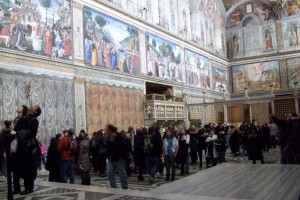
Inside the Sistine Chapel
Many priests, nuns and seminarians were assigned full time to the Basilica for the special occasion, but others, like myself, were lay persons who dedicated our free time as volunteers to accompany pilgrims and explain the wonders of the Basilica.
We welcomed Italian and Irish parish groups led by earnest, ruddy-faced country priests, school groups from every European country, entire families, servicemen on leave, individual tourists, pilots and truck drivers, lawyers and refugees, ballet dancers and businessmen – all of whom became pilgrims if for just a few hours, as they were shown around the Basilica.
Thousands converged on St. Peter’s from every corner of the globe: from Scotland, Samoa, New Guinea, South Africa, Sri Lanka, Sweden, Kenya and Bangladesh, from Singapore and Holland they came often dressed in their traditional costumes and using English as our common language we were able to introduce them to the Basilica that is the “summa” of Christianity and make them feel at home.
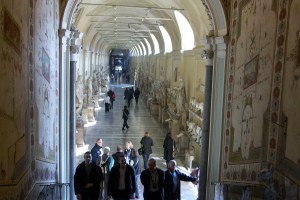
Sculpture Hall, Vatican Museums
For visitors from “new” countries it was a first contact with many concepts of art and history as well. They wanted to know what a mosaic was, if the statues and monuments were arranged in chronological order, how to read Roman numerals. “Where is the Sistine Chapel?” was the most asked question thanks to the popular book and film “The Agony and the Ecstacy”.
Even now, decades later, the memories remain deeply impressed. The brightly garbed cardinals and bishops processing around the Basilica every evening, the “sampietrino” who, while cleaning the top of Bernini’s canopy which towers 29 metres over the main altar, discovered his grandfather’s name and a date scratched into the metal.
Some Sunday afternoons it seemed that half the Italian population was trying to enter the Holy Door at the same time, and crowd control was up to us. Sister Cecilia would lead hymns over the loudspeaker to keep the crowds from pushing and Father Casimiro, who dedicated his time to the Polish pilgrims long before being Polish was fashionable in Vatican circles, chanted in Latin so more people could understand.
Many late afternoons we would watch with awe as rays of sun poured through the high windows on the right, cutting a swath of light in the Basilica’s dark interior. Not only did Michelangelo know how to use stone and marble, but he also made sunlight his accomplice to create moments of breath taking beauty for future generations of visitors to St. Peter’s.
For more about Vatican, St. Peter’s Basilica and life in Rome and on the Via Francigena use the search bar on my blog 50yearsinItaly.
